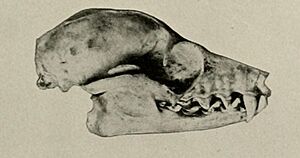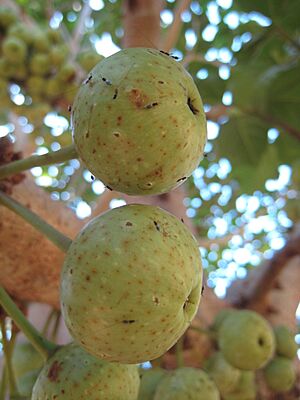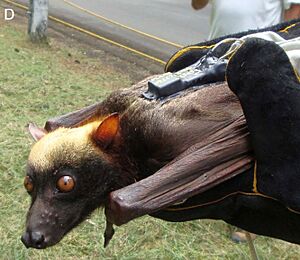Giant golden-crowned flying fox facts for kids
Quick facts for kids Giant golden-crowned flying fox |
|
|---|---|
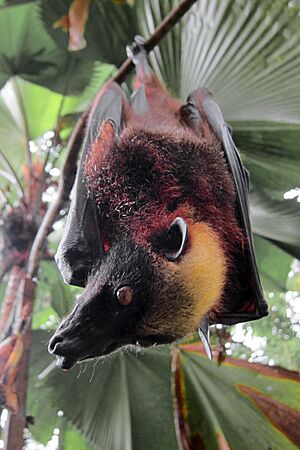 |
|
| Conservation status | |
| Scientific classification | |
| Genus: |
Acerodon
|
| Species: |
jubatus
|
 |
|
| Giant golden-crowned flying fox range: extant possibly extirpated extirpated | |
| Synonyms | |
|
|
The giant golden-crowned flying fox (Acerodon jubatus), also known as the golden-capped fruit bat, is a very large bat found only in the Philippines. It's one of the biggest bat species in the world! It can weigh up to 1.4 kilograms (about 3 pounds). Only a couple of other bat species are heavier. This bat also has the longest forearms of any bat, measuring about 21 centimeters (8.3 inches).
These bats mainly eat fruit, especially different kinds of figs, and sometimes leaves. They hunt for food at night and sleep during the day. They often sleep in large groups, sometimes with thousands of other bats. They even share their sleeping spots with another big bat called the large flying fox.
We don't know much about how they have babies. Females usually have one baby each year, between April and June. Sadly, the giant golden-crowned flying fox is an endangered species. This is mainly because their forest homes are being cut down and they are hunted by people. Even though hunting them is against the law, it still happens.
Contents
About the Giant Golden-Crowned Flying Fox
What's in a Name?
Scientists gave the giant golden-crowned flying fox its name in 1831. The scientist, Johann Friedrich von Eschscholtz, first put it in the Pteropus group of bats. Its scientific name, jubatus, comes from a Latin word meaning "having a mane or crest." This fits because of the bat's golden fur on its head! Later, scientists decided it was special enough to be in its own group, called Acerodon.
How to Spot One
The giant golden-crowned flying fox looks a lot like other large bats. But it has some special features. Its teeth are a bit different, with smaller canine teeth and larger back teeth.
This bat is truly huge! It can weigh as much as 1.4 kilograms (3.1 pounds). Its wingspan can reach an amazing 1.5 to 1.7 meters (about 5 to 5.6 feet). That's taller than most kids! Male bats are usually a little bigger than females.
The bat gets its common name from its fur color. It has a bright golden patch of fur on its head, starting between its eyes. This golden patch often forms a "V" shape on the back of its neck. The sides of its face and throat are black. Its neck and upper back are maroon, which fades into brownish-black. Its belly is mostly black, sometimes with yellow hairs mixed in.
Life and Habits
What Do They Eat?
Giant golden-crowned flying foxes are mostly fruit-eaters. They especially love Ficus fruits, also known as figs. Studies show that fig seeds are found in most of their droppings! They also eat some leaves. Figs are a great source of calcium, which helps them grow strong.
Since these bats don't use sound to find their way (like some other bats do), they rely on their excellent eyesight. They often fly long distances at night to find food. For example, some bats were seen flying over 12 kilometers (7.5 miles) from one island to another just to find food!
Sleeping and Social Life
Giant golden-crowned flying foxes are active at night. During the day, they mostly sleep, hanging upside down in trees. Sometimes, they wake up to groom themselves or flap their wings. In the mornings, they might fight or even mate.
They often share their sleeping trees with another large bat, the large flying fox. These mixed groups can be huge! In the 1920s, some colonies had as many as 120,000 bats. Today, the largest groups are around 5,000 bats, and many are much smaller. When it's time to leave for their nightly hunt, both species fly off in the same direction.
Reproduction and Life Cycle
We don't know a lot about how these bats have babies. Females usually have only one baby at a time, and they likely give birth once a year. Some scientists think females might only have a baby every other year. It's also thought that females might not be ready to have babies until they are two years old.
Babies are usually born in April, May, or June, depending on the area. Parents work hard to help their babies survive and grow. These bats can live for a long time in the wild, sometimes up to 13 to 30 years! However, they face dangers from predators like eagles and pythons, and from humans who hunt them.
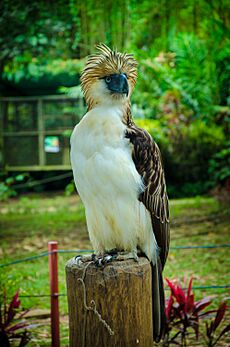
Besides humans, other animals that hunt these bats include the Philippine eagle, the white-bellied sea eagle, and the reticulated python.
Where They Live
The giant golden-crowned flying fox lives only in the Philippines. It was the first animal found only in the Philippines to be described by scientists. They have been seen on islands like Bohol, Boracay, Cebu, Leyte, Luzon, Mindanao, Mindoro, Negros, and Polillo. Sadly, they used to live on Panay Island, but they are no longer found there.
These bats love forests, especially those from sea level up to about 1,100 meters (3,600 feet) high. They prefer places where humans don't live. They also seem to use areas along rivers, called riparian zones, more than expected. This is because many fig trees, their main food source, grow near rivers. They like to be near farms, but only if the forest around them is untouched.
Protecting These Bats
The giant golden-crowned flying fox is an endangered species. This means its numbers have dropped by more than half in recent years. One of the biggest reasons for this decline is hunting for food. Because they are so big, they are an easy target for hunters. Hunters might shoot many bats, but only recover a few, leading to a lot of waste.
Another major threat is deforestation, which is when forests are cut down. The Philippines has lost a lot of its forests. For example, Negros Island, where these bats live, has only 4% of its original forest left.
There are laws to protect these bats. An international agreement called CITES (Convention on International Trade in Endangered Species of Wild Fauna and Flora) makes it illegal to trade these bats for money. The Philippines also has a law to protect them. However, these laws are not always strongly enforced, so hunting still happens.
Even in places where hunting is controlled, the bats still face problems. Tourists sometimes disturb them by clapping or tapping on trees to make them fly. This keeps the bats from sleeping and can even separate baby bats from their mothers.
Groups like Bat Conservation International (BCI) are working to help these bats. They partner with local groups in the Philippines to protect the bats' homes and teach people about how important bats are. There are also some programs to breed these bats in zoos, but it's not clear if this is enough to help their numbers grow in the wild.



